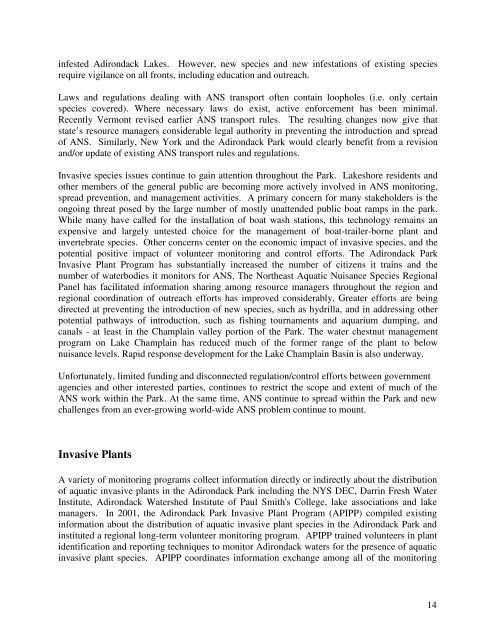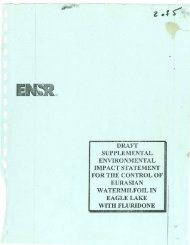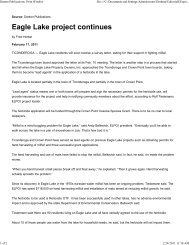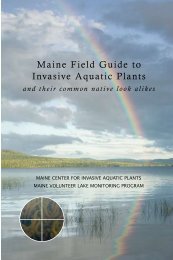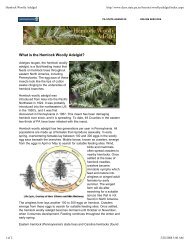Adirondack Park - Eagle Lake Property Owner's Inc.
Adirondack Park - Eagle Lake Property Owner's Inc.
Adirondack Park - Eagle Lake Property Owner's Inc.
You also want an ePaper? Increase the reach of your titles
YUMPU automatically turns print PDFs into web optimized ePapers that Google loves.
infested <strong>Adirondack</strong> <strong>Lake</strong>s. However, new species and new infestations of existing species<br />
require vigilance on all fronts, including education and outreach.<br />
Laws and regulations dealing with ANS transport often contain loopholes (i.e. only certain<br />
species covered). Where necessary laws do exist, active enforcement has been minimal.<br />
Recently Vermont revised earlier ANS transport rules. The resulting changes now give that<br />
state’s resource managers considerable legal authority in preventing the introduction and spread<br />
of ANS. Similarly, New York and the <strong>Adirondack</strong> <strong>Park</strong> would clearly benefit from a revision<br />
and/or update of existing ANS transport rules and regulations.<br />
Invasive species issues continue to gain attention throughout the <strong>Park</strong>. <strong>Lake</strong>shore residents and<br />
other members of the general public are becoming more actively involved in ANS monitoring,<br />
spread prevention, and management activities. A primary concern for many stakeholders is the<br />
ongoing threat posed by the large number of mostly unattended public boat ramps in the park.<br />
While many have called for the installation of boat wash stations, this technology remains an<br />
expensive and largely untested choice for the management of boat-trailer-borne plant and<br />
invertebrate species. Other concerns center on the economic impact of invasive species, and the<br />
potential positive impact of volunteer monitoring and control efforts. The <strong>Adirondack</strong> <strong>Park</strong><br />
Invasive Plant Program has substantially increased the number of citizens it trains and the<br />
number of waterbodies it monitors for ANS. The Northeast Aquatic Nuisance Species Regional<br />
Panel has facilitated information sharing among resource managers throughout the region and<br />
regional coordination of outreach efforts has improved considerably. Greater efforts are being<br />
directed at preventing the introduction of new species, such as hydrilla, and in addressing other<br />
potential pathways of introduction, such as fishing tournaments and aquarium dumping, and<br />
canals - at least in the Champlain valley portion of the <strong>Park</strong>. The water chestnut management<br />
program on <strong>Lake</strong> Champlain has reduced much of the former range of the plant to below<br />
nuisance levels. Rapid response development for the <strong>Lake</strong> Champlain Basin is also underway.<br />
Unfortunately, limited funding and disconnected regulation/control efforts between government<br />
agencies and other interested parties, continues to restrict the scope and extent of much of the<br />
ANS work within the <strong>Park</strong>. At the same time, ANS continue to spread within the <strong>Park</strong> and new<br />
challenges from an ever-growing world-wide ANS problem continue to mount.<br />
Invasive Plants<br />
A variety of monitoring programs collect information directly or indirectly about the distribution<br />
of aquatic invasive plants in the <strong>Adirondack</strong> <strong>Park</strong> including the NYS DEC, Darrin Fresh Water<br />
Institute, <strong>Adirondack</strong> Watershed Institute of Paul Smith's College, lake associations and lake<br />
managers. In 2001, the <strong>Adirondack</strong> <strong>Park</strong> Invasive Plant Program (APIPP) compiled existing<br />
information about the distribution of aquatic invasive plant species in the <strong>Adirondack</strong> <strong>Park</strong> and<br />
instituted a regional long-term volunteer monitoring program. APIPP trained volunteers in plant<br />
identification and reporting techniques to monitor <strong>Adirondack</strong> waters for the presence of aquatic<br />
invasive plant species. APIPP coordinates information exchange among all of the monitoring<br />
14


